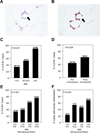Menopause is a determinant of breast adipose inflammation
- PMID: 25720743
- PMCID: PMC4417434
- DOI: 10.1158/1940-6207.CAPR-14-0243
Menopause is a determinant of breast adipose inflammation
Abstract
Chronic inflammation is recognized as a risk factor for the development of several malignancies. Local white adipose tissue (WAT) inflammation, defined by the presence of dead or dying adipocytes encircled by macrophages that form crown-like structures (CLS), occurs in the breasts (CLS-B) of most overweight and obese women. Previously, we showed that the presence of CLS-B is associated with elevated tissue levels of proinflammatory mediators and aromatase, the rate-limiting enzyme for estrogen biosynthesis. The associated increased levels of aromatase in the breast provide a plausible mechanistic link between WAT inflammation and estrogen-dependent breast cancers. Thus, breast WAT inflammation could be relevant for explaining the high incidence of estrogen-dependent tumors with aging despite diminished circulating estrogen levels after menopause. To explore this possibility, we determined whether menopause in addition to body mass index (BMI) is associated with breast WAT inflammation among 237 prospectively enrolled women. The presence of CLS-B and its severity (CLS-B/cm(2)) as indicators of WAT inflammation correlated with menopausal status (P = 0.008 and P < 0.001) and BMI (P < 0.001 for both). In multivariable analyses adjusted for BMI, the postmenopausal state was independently associated with the presence (P = 0.03) and severity of breast WAT inflammation (P = 0.01). Mean adipocyte size increased in association with CLS-B (P < 0.001). Our findings demonstrate that breast WAT inflammation, which is associated with elevated aromatase levels, is increased in association with the postmenopausal state independent of BMI. Breast WAT inflammation, a process that can potentially be targeted, may help to explain the high incidence of estrogen-dependent tumors in postmenopausal women.
©2015 American Association for Cancer Research.
Figures


References
-
- Mantovani A, Allavena P, Sica A, Balkwill F. Cancer-related inflammation. Nature. 2008;454:436–444. - PubMed
-
- van Kruijsdijk RC, van der Wall E, Visseren FL. Obesity and cancer: the role of dysfunctional adipose tissue. Cancer epidemiology, biomarkers & prevention : a publication of the American Association for Cancer Research, cosponsored by the American Society of Preventive Oncology. 2009;18:2569–2578. - PubMed
-
- Calle EE, Kaaks R. Overweight, obesity and cancer: epidemiological evidence and proposed mechanisms. Nature reviews Cancer. 2004;4:579–591. - PubMed
Publication types
MeSH terms
Grants and funding
LinkOut - more resources
Full Text Sources
Medical

